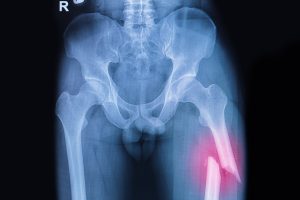 Osteoporosis medications can cause a small risk of thigh bone fractures, according to a new study. Fifth coauthor Patrick Strotman said, “Attempts to medically manage osteoporosis have created a new ‘atypical’ fracture pattern that must be recognized and managed appropriately.” The osteoporosis drugs in question are known as bisphosphonates and are typically taken to increase bone mineral density.
Osteoporosis medications can cause a small risk of thigh bone fractures, according to a new study. Fifth coauthor Patrick Strotman said, “Attempts to medically manage osteoporosis have created a new ‘atypical’ fracture pattern that must be recognized and managed appropriately.” The osteoporosis drugs in question are known as bisphosphonates and are typically taken to increase bone mineral density.
Studies found that bisphosphonates decrease the risk of fractures in the vertebrae by 50 percent, and in other bones by 40 percent. On the other hand, the drugs can also increase the risk of fractures in the femur with little or no force trauma. Atypical femur fractures are commonly seen after three years of taking bisphosphonates.
Advertisement
Treatment for atypical femur fractures should begin with cessation of the osteoporosis drug, while calcium and vitamin D supplements should be increased. The authors wrote, “The current recommended dosing for calcium and vitamin D are under debate and may be too low for the majority of those affected.”
Complete fractures should be treated with surgically implanted titanium rods.
The authors continued, “Physicians responsible for the management of osteoporosis must be aware of this issue, be able to diagnose these fractures before they are complete, and have a strategy for managing bisphosphonate therapy long term.”
“While hip fractures only account for 15 percent of osteoporosis-related fractures, they are associated with poor patient outcomes and increased financial burden, accounting for over 70 percent of fragility fracture-associated healthcare costs,” the authors wrote.
Outcomes related to fractures in seniors can be improved with immediate surgical intervention.
How to lower the risk of thigh bone fracture (femur fracture)
A femur fracture is a break in the thigh bone caused by high-speed trauma or a pre-existing bone disease like osteoporosis. Symptoms of a femur fracture include extreme pain, inability to move the leg or stand, swelling of the hip area, bleeding from an open wound if the bone breaks the skin, change in shape of the thigh bone, severe bruising or skin discoloration, muscle spasms in the thigh, and numbness or tingling in the affected leg.
Advertisement
Tips for thigh bone fracture prevention include:
- Don’t drive under the influence
- Always wear your seatbelt
- Don’t drive motorcycles aggressively or in inclement weather
- Reduce your risk of osteoporosis
- Wear appropriate equipment when partaking in contact sports
Treatment for a thigh bone fracture can involve physical therapy and surgery.
Complications arising from thigh bone fracture include bleeding due to sharp bones cutting blood vessels, a highly painful condition known as acute compartment syndrome, and open fractures, which expose the bone to the environment, increasing the risk of infection.
